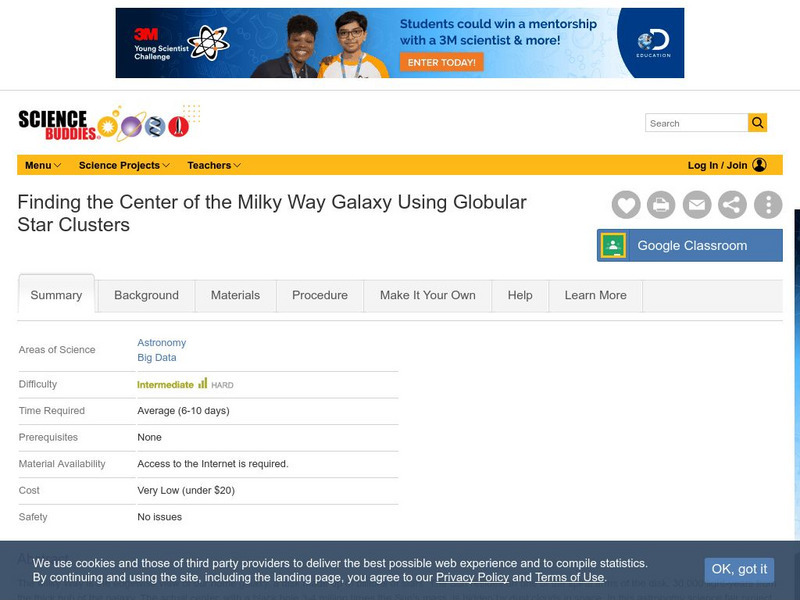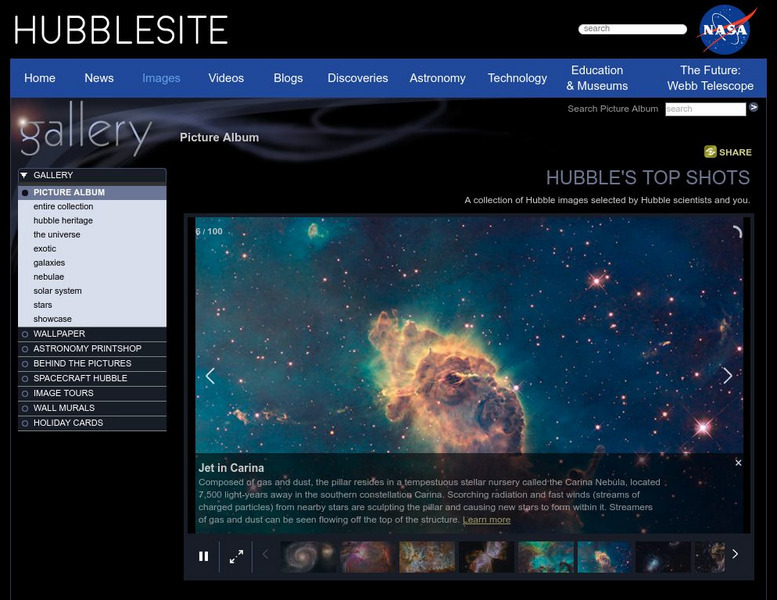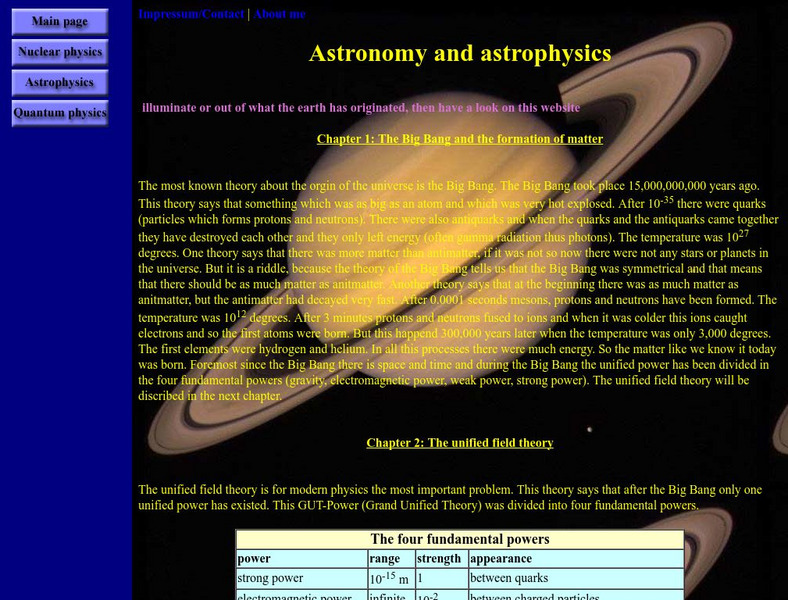Science Buddies
Science Buddies: Similar Triangles: Using Parallax to Measure Distance
Want to stretch your imagination? One good way is to try to imagine how far it is to a distant star. How much farther away is it than the moon is from the earth? In this project, you'll learn one way of measuring the distance without...
Science Buddies
Science Buddies: Find Center of Milky Way Galaxy Using Globular Star Clusters
The Milky Way is the edgewise view of our home galaxy, a disk made up of billions of stars. The Sun resides on one of the spiral arms of the disk, 30,000 light-years from the thick hub of the galaxy. The actual center, with a black hole...
Science Education Resource Center at Carleton College
Serc: Planets Made Real: Creating Size and Distance Scale of Planets
An activity where students build a scale model of the solar system based on a marble they pick from a bowl. After choosing a marble that represents Earth, students must calculate the size of the other planets and the sun. Site includes...
Science Education Resource Center at Carleton College
Serc: Know Your Neighbors: Researching the Planets
Students will study planets and moons in our solar system by working online and other resources. This lesson plan has students working together to generate a spreadsheet of data found. Students will use this information to describe why...
Space Telescope Science Institute
Hubble Site: Images From Space
This site provides vivid images taken in space by the Hubble Telescope. You can view the entire collection or choose an area you enjoy the most. Explore galaxies, the solar system, nebulae and more!
ACT360 Media
Act Den: Sky Den
This journey will help you solve big questions about the universe. You will be able to see beyond human capabilities and will learn what scientists are discovering.
Wikimedia
Wikipedia: Comet
A nice encyclopedia article from Wikipedia on comets describes what they are, their physical characteristics, gives a history of comet study, and provides a list of well-known comets.
American Institute of Biological Sciences
Action Bioscience: Looking for Life on Mars and Beyond
Learn some of the characteristics of Mars. These characteristics lead some people to believe that life forms may be found on the fourth planet from the Sun.
PBS
Pbs Learning Media: Scaled Images of the Solar System
Use the following lithographs to envision the scale of our solar system. View different models of planets at different scales, an infographic about the relative sizes of the planets and distance from the sun, and images of the largest...
California Institute of Technology
Cool Cosmos: Ask an Astronomer
Explore the mysteries of the black hole! Cool Cosmos presents the answers to the most frequently asked questions about this phenomenon. Kids can click on the easy to use question links to find out more.
PBS
Pbs: People & Discoveries: Ernest Rutherford
A lovely biographical piece about Ernest Rutherford. A number of personal notes, along with extensive information about the physics work he did. Nice quote at the end.
Harvard University
Harvard University: The Solar System
These hands-on activities are a great way for students to gain perspective on the relative sizes and distances of each planet, the relationship between the sun and Earth, and much more.
Other
Astronomylinks
This is a very comprehensive site on the subject of Astronomy and Astrophysics. The site has links to many sites on topics including astronauts, astronomy, astrophysics, education, jobs, etc.
Other
Astronomy and Astrophysics
This site is about Astronomy and Astrophysics. The site has plenty of information and links to related topics.
Other
Celestia
This site provides a free space simulation that lets you explore the universe in three dimensions. There is a forum for teachers and lesson plans that help enhance student use of the simulation. A program must be downloaded in order to...
Harvard University
Harvard University: Eye on the Sky, Feet on the Ground
An ebook filled with information and classroom activities covering several astrological topics such as the Earth's rotation and the solar system. Many tips and teaching tools are available to aid in discovering what the sky has to offer.
Other
Physics.org: A Grain of Sand Covers 10,000 Galaxies
A fascinating look at how big our solar system really is. Shows how we can only see a tiny bit of our vast universe.
Other
Simple Science: Planetary Gallery
The innovative resource examines images of the Sun, Moon, Pluto, and all eight planets in the Solar System. Learners calculate the diameter of each object and rank the objects in order of size. The activity has an interactive online...
NASA
Nasa: 21th Century Explorer: Why Do We Want to Study and Travel to Mars?
This article answers some of the most common questions about Mars: Why is it red? Is there water on Mars? What else have scientists discovered from spacecraft that have landed there? Also, visitors can follow links to learn more about...
PBS
Pbs Learning Media: Our Solar System Lithograph Set
View these amazing high-quality images of our solar system from NASA with this lithograph set. Each lithograph contains images, facts, dates, and general information on a particular subject. Background information and teaching tips are...
Other
University of Leicester: Comets, Asteroids & Meteorites
Provides a general overview of comets, asteroids, and meteorites. Content includes ways to identify them in the night sky, as well as detailed information on each type of small body.
California Institute of Technology
Cool Cosmos: Ask an Astronomer: Neptune
Resource provides a deeper look at the planet Neptune. Just click on the frequently asked question link and dive into knowledge.
Other
Cometography.com: C/1995 01 (Hale Bopp)
This site provides a detailed overview of the comet C/1995 01 (Hale-Bopp), the great comet of 1997. Content includes discovery, and observational and orbit information, as well as several images.
California Institute of Technology
Cool Cosmos: Ask an Astronomer: Pluto
Visit this site and learn more about Pluto. Provides the answers to kids' most frequently asked questions.



















